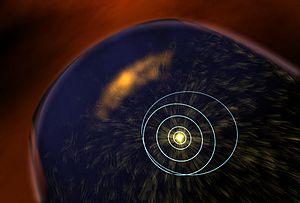Coronal mass ejection facts for kids

A coronal mass ejection (often called a CME) is a giant burst of plasma (which is like a super hot, electrically charged gas) and magnetic field that shoots out from the Sun's outer atmosphere, called the solar corona. These powerful explosions often happen after solar flares or during a solar prominence eruption. The plasma from a CME travels through the solar wind and can be seen with special telescopes called coronagraphs.
Contents
Where Do CMEs Come From?
CMEs usually start in active areas on the Sun's surface. These areas often have groups of sunspots and many solar flares. Scientists are still working to fully understand how CMEs are connected to other solar events.
How Often Do CMEs Happen?
The number of CMEs changes with the Sun's activity cycle.
- Near solar maxima, which is when the Sun is most active, there can be about three CMEs every day.
- Near solar minima, when the Sun is less active, there is only about one CME every five days.
What Happens When a CME Reaches Earth?
When a CME travels towards Earth, it can hit our planet's magnetic field. This can cause a "geomagnetic storm." The biggest known geomagnetic storm happened in 1859 and is called the Carrington Event.
During the Carrington Event, the storm was so strong that it affected the new telegraph networks in the United States. It caused sparks and even started some fires! Interestingly, some telegraph operators could still send messages even after disconnecting their batteries. This was because the storm created electric currents in the telegraph lines, powered by the beautiful aurora lights that appeared in the sky.
Images for kids
-
Coronal mass ejections are usually visible in white-light coronagraphs. Here, the white circle represents the size of the Sun.
-
Photo from the ISS of aurora australis during a geomagnetic storm on 29 May 2010. The storm was most likely caused by a CME that had erupted from the Sun on 24 May 2010, five days prior to the storm.
See also
 In Spanish: Eyección de masa coronal para niños
In Spanish: Eyección de masa coronal para niños




